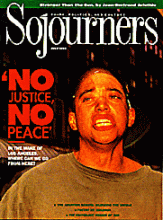A letter from a friend reads, "Watching the painful images of Los Angeles in flames caused me to think of your community, always living in the middle of a 'low intensity riot.'"
This image has stuck with me. We describe wars of "low intensity conflict" in places such as El Salvador, South Africa, and the Philippines. But what is happening all the time in South Central LA, inner-city Washington, D.C., and countless other urban caldrons of human suffering across America can, in truth, be termed a low intensity riot. Tonight, the children in the inner cities of the world's only remaining superpower will go to bed to the sound of gunfire.
As we have seen the last few weeks, it only takes a spark to escalate from low intensity to high intensity. When the explosion comes, the preferred term on the street is "rebellion."
The next time someone says violence doesn't work, tell them they're wrong. It doesn't solve any problems, but it surely gets attention. In America, violence is about the only thing that makes us see the poor or even remember that they exist. The Los Angeles rebellion broke the long, frightening silence in both the media and the highest levels of national political leadership about the disintegration of life and society that is now the norm of existence in vast inner-city territories.
Since the riots, the media have been full of compelling stories about the destructive consequences, particularly for the young, of living without education, jobs, health, home, security, respect, hope, and any promise for the future. Politicians who have had little or nothing to say about the cities and the poor now are blaming each other for the problems.
Read the Full Article

